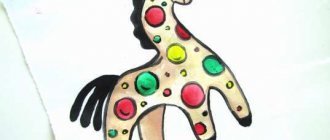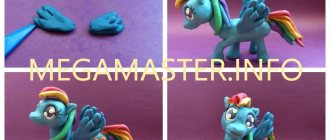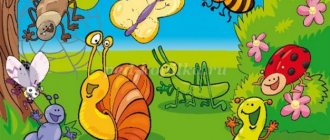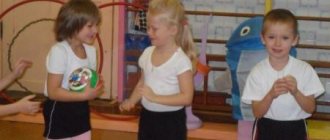Lesson on familiarization with Dymkovo painting
Technological map for familiarization with decorative drawing (“Dymkovo painting”)
Topic: “Introduction to Dymkovo toys, elements of Dymkovo painting.”
Age group: senior group.
Educational field, integration of educational fields: artistic and aesthetic development is a priority, cognitive and socio-communicative development are integrated.
Goal: to familiarize children with folk crafts, consolidate and deepen knowledge about Dymkovo toys and their painting.
Tasks:
educational:
— Enrich children’s knowledge about Dymkovo toys and Dymkovo painting;
— To form an emotionally positive attitude towards folk decorative art.
developing:
— Develop aesthetic perception, figurative ideas, sense of color and composition;
- Develop a sense of beauty;
educational:
— To cultivate respect for the work of folk craftsmen.
Additional tasks: expand children’s knowledge and ideas about Dymkovo toys and painting; to cultivate in children the desire and ability to interact with peers and teachers.
Vocabulary work:
enrichment of the dictionary: Dymkovo toys, Dymkovo painting.
activation of the dictionary: painting.
Materials, equipment (facilities): an exhibition of Dymkovo toys, a letter with a legend about the Dymkovo toy, a presentation with illustrations on the topic (Dymkovo toy, Dymkovo masters, elements of painting, the village of Dymkovo, visual material for the DIY “Find the odd one”).
Methods and techniques (methods): use of visual materials, surprise moment, problematic question, artistic expression, conversation, display, explanation, reflection, positive assessment.
Preparatory (preliminary) work: conversation with children about paintings based on the children’s personal experience and knowledge.
Form of organization: frontal, children sit in a semicircle on chairs.
Planned outcome of the lesson: children are familiar with folk crafts, children’s knowledge about Dymkovo toys and their painting is consolidated and deepened, children answer questions creatively.
| № | Stages, duration | Stage tasks | Activities of a teacher | Suggested activities for children | Expected Result |
| 1. | Organizational and motivational stage (introductory part) | Get children interested in the upcoming activity. | Educator: Hello, guys! Today we will visit the exhibition (the teacher takes the children to a pre-prepared place with illustrations of Dymkovo toys, craftsmen, and the village of Dymkovo itself). Educator: Look how beautiful it is here. This is the village of Dymkovo. There are many folk craftsmen there. What do you guys think, what do these masters do? | Children: Hello! Children: toys. | Children are interested in the upcoming activity. |
Continue to introduce children to the Dymkovo toy as a type of folk arts and crafts to enrich visual impressions, develop aesthetic feelings and assessments. Draw children's attention to the figurative expressiveness of objects of art. To form ideas about some artistic crafts, knowledge about what materials and tools craftsmen use (to make toys you need: clay, a pottery wheel, a special stick or brush to draw a pattern, a stove to fire the product, special paints for painting).
Preliminary work.
Examination of objects of decorative and applied art, conversation about the fact that all these beautiful things were created by masters - folk craftsmen.
Materials, tools, equipment.
4-5 Dymkovo toys (lady, horse, turkey, ram, etc.), a rotary disk for displaying toys or a stand, decoration for performing a mini-play; didactic manual (table) with characteristic color combinations and decorative elements of the Dymkovo craft. Album for children's creativity I.A. Lykova “Dymkovo toy”.
Contents of the lesson.
The teacher introduces the children to the Dymkovo toy.
Approximate content of the teacher’s story “Toys are not simple - clay, painted.”
— From the high bank of the Vyatka River, on which the city of Vyatka stands, you can see the village of Dymkovo. Why is it called that? In the old days - both in winter, when the stoves were lit, and in summer, when there was fog, this village seemed to be shrouded in haze, everything was in smoke. Here, in ancient times, a toy was born, which was called “Dymkovo”...
In the beginning there were whistles. All winter the women of Dymkovo sculpted them for the fair. From a small clay ball with holes, the whistle turned into a duck, a cockerel, or a skate. And now on the trays and counters of the crowded spring fair they sell cheerful goods. Adults and children willingly take it apart. The whole area resounds with whistling. The people's festivities are noisy, but the loudest sound is the loud whistle. That is why this spring holiday got its name - “Whistling”. A new winter comes, and again in Dymkovo they get down to business. And so on for many, many years. Grandmothers teach their granddaughters, and granddaughters teach their granddaughters.
And in our time, in Vyatka, which is now called Kirov, there are workshops of the famous Dymkovo toys. And they make not only whistles there. If we go into these workshops, we will immediately see piles and bags of clay, boxes of paints, boxes of eggs. All this is needed to create a miracle. Fairytale horses, turkeys that look like firebirds, sheep in pants, ladies and gentlemen, carousels, even stoves - one with Emelya, and the other with kids, and all this is a real miracle.
When you watch a craftswoman at work, it seems that everything is very simple. So she pinched off a piece of clay, rolled it into a sausage, then she took more clay, slammed it into a cake, then she rolled the cake into a funnel - it turned out to be a skirt. She attached a head and arms on top, bent the sausage with a rocker, sculpted buckets, put a tall kokoshnik on her head, and attached a tiny nose. I left the figurine to dry first on the bench and then in the oven.
The figurines that emerge from the oven are hardened, strong, and sonorous. They are whitened with chalk diluted in milk, then they begin to paint. And patterns come out from under the brush: circles, straight and wavy stripes, cells, spots, dots. Everything is in its place and everything burns bright and bright. The colors are crimson, red, green, yellow, orange, blue - colorful and cheerful, like in a round dance!
But it turns out that the work is not finished yet. There is still a lot of gold to be planted. The craftswoman wets the brush in raw egg, lightly touches the golden square or diamond and “plants” it in the right place - for ladies and water bearers on kokoshniks and hats, for roosters - on combs... Now the toys glow and become even brighter.
The teacher creates interest in the Dymkovo toy: he shows three or four figures that came to visit the children, and plays out the emotional dialogue between them. Invites children to look at Dymkovo toys and tell about them what they are like (fun, elegant, bright, beautiful). He reports that in the next classes the children will sculpt and paint Dymkovo toys like real masters.
Summary of the lesson “Dymkovo toy” for children of the preparatory group
Summary of the lesson “Dymkovo toy” for children 6-7 years old
Author: Naira Igorevna Nersesyan, teacher at MBDOU “General developmental kindergarten No. 144”, Voronezh
Purpose: teachers of senior and preparatory groups, primary school teachers, parents. Goal: Introducing children to folk culture. Objectives: -Introduce the history of the Dymkovo toy. -To cultivate love and respect for the work of folk craftsmen, for the folk art of Russia. -To consolidate children’s knowledge about the process of making Dymkovo toys and the ability to talk about it. -To develop knowledge about the characteristic features of painting toys, the ability to create patterns according to one’s own design. Learn to identify the elements of the geometric pattern of Dymkovo painting (circles, straight and wavy lines, checkered patterns, dots and peas). Learn to paint with Dymkovo patterns. -Develop aesthetic perception, sense of rhythm, color, creativity. Deepen aesthetic knowledge of folk arts and crafts. Preliminary work: drawing up a presentation “Dymkovo toy”, original Dymkovo toys for demonstration, printed stencils on white paper (A4 format) and colored pencils. Lesson plan: - 1. Organizational point 2. Theoretical part.
An introductory conversation about the history and process of creation with a demonstration of Dymkovo toys, paintings, presentations. An explanation of the painting sequence. 3. Final part. Progress of the lesson
Educator: Guys, you all have toys, but what are they made of? Children: Our toys are made of plastic, rubber, metal, wood, fabric. Educator: Let's find out what toys are made in the village of Dymkoye? What is Dymkovo famous for? With his toy. There is no smoky color in it, But there is the love of people. There is something in it from the rainbow, from drops of dew. There is something of joy in her, thundering like bass. (V. Feofanov) Educator: People affectionately and tenderly call this toy “haze.” Where does such an amazing name come from? Let us introduce you to Dymkovo clay toys. I was born in the large settlement of Dymkovo across the river near the city of Vyatka. In ancient times, residents of this settlement, young and old, sculpted clay toys for the spring fair. In winter, the entire settlement is in smoke from the fact that the stoves are heated and toys are burned. On cloudy days, the fog from the river spreads like a light haze. Perhaps this is where the name Dymkoye arose, and the toys began to be called Dymkovo. Dymkovo toys were made for the ancient holiday "Whistling Dance". Later, the fair-festival began to be called "Whistling". What kind of toys are these, let's see? Through the mountain spurs, Through the roofs of villages, A red-horned, yellow-horned clay deer rushes.
Here is a smart turkey, He is all so fine, The big turkey has all his sides painted. Look, his fluffy tail is not at all simple, It’s like a sunny flower, and then there’s the comb.
The Dymkovo young lady is all in orange, gold, scarlet and green patterns.
Look how beautiful this girl-soul is, her scarlet cheeks are burning, her outfit is amazing. Even the horses are in festive outfits.
Clay horses race on stands as hard as they can. And they won’t hold on to the tail if they lose the mane. Educator: What do all these toys have in common? Children: All toys have bright colors, everything is on a white background, covered with beautiful patterns. Educator: What paint do you think the toy is first coated with? Children: White. On a white background, the patterns stand out well and beautifully.. Educator: Can you guess where the masters got the white color from? Children: They took it from the snow, from winter. The toys were made in winter!!! Educator: That's right. The craftsmen took the white background from the snow-covered fields, when in winter everything around is white and white. In those places, the winter is long and there is a lot of snow. The craftsmen want to make the toy as clean and white as snow. Why are they bright?
Children: Because they were made for the holiday, so they painted them with bright colors. Educator: What colors did the masters use to paint toys? Children: They used bright colors: red, blue, crimson, yellow, orange, green. Educator: What patterns do you see on the toys? Children: On the toys there are circles, dots, lines, squares, stripes, curves, waves, squares, rings, ovals. Educator: What images can be seen in Dymkovo toys? Children: Horse, cockerel, deer, ram, young lady. Educator: The most common subjects: nannies with children, water carriers, rams with golden horns, turkeys, roosters, deer and, of course, young people, buffoons, ladies. Educator: Let's find out how a toy is created? (Children watch the video on the interactive board, the teacher talks at the same time). A lot of work must be put into making the toy so elegant. It is born three times. The first time it is born is when it is sculpted from red clay. The figures are sculpted in parts, individual parts are assembled and completed, using liquid red clay as a binding material. The molding marks are smoothed out to give the product a smooth and neat surface. The toy must be burned to make it durable. The intense heat causes the toy to become hot, and when it cools down, the clay becomes ringing and strong. This is how the toy is born a second time. There is a trial by fire. And when is the third time born? Children: The third time a toy is born is when it is whitened and painted. Educator: Then it is whitewashed with chalk diluted with milk and painted. Sometimes pieces of gold leaf are stuck on top of the pattern, which gives the toy even more elegance. This is how it is born for the third time. Beautiful, bright, elegant toys are sold at the fair. Making a toy, from modeling to painting - the process is unique and creative, never repeated. There are not and cannot be two absolutely identical products. Each toy is unique, unique and inimitable.
Educator: I suggest you become real folk craftsmen and paint the stencils of the Dymkovo toy. Printed stencils are distributed to children. They begin to “paint” with pencils with pleasure. In the process of independent work, the teacher provides children with complete creative freedom, providing individual assistance. You can turn on soft folk music. At the end of the lesson there is an exhibition.
We recommend watching:
Lesson with older preschoolers. Dymkovo toy Lesson notes on labor training in 2nd grade Notes of GCD in the middle group. Dymkovo toy Abstract of the GCD for sculpting “Dymkovo toy”. Preparatory group
Similar articles:
Modeling figures from plasticine
Master class for preschool teachers. Dymkovo lady
Lesson notes for the middle group. Dymkovo toy





